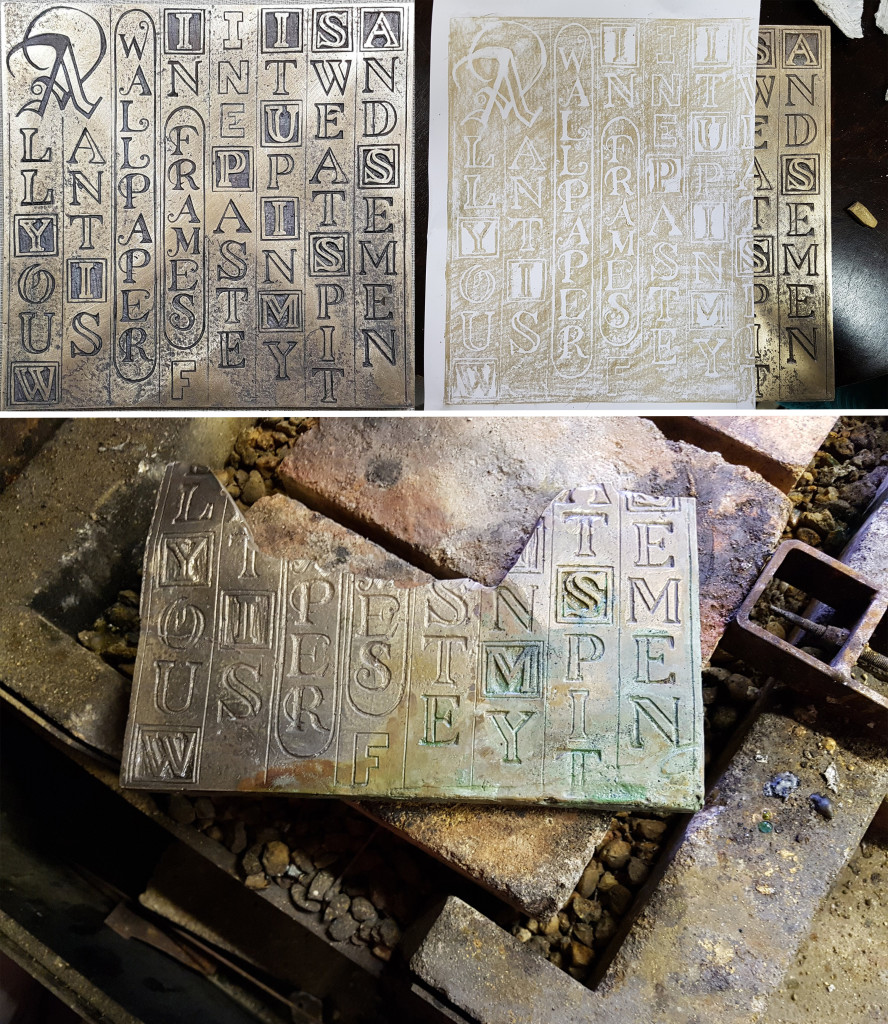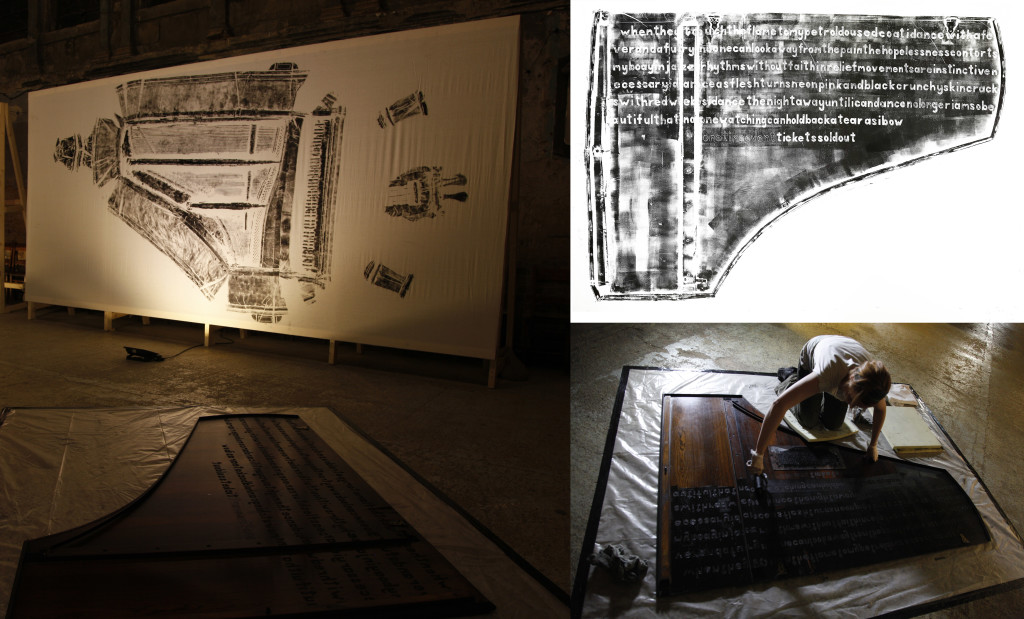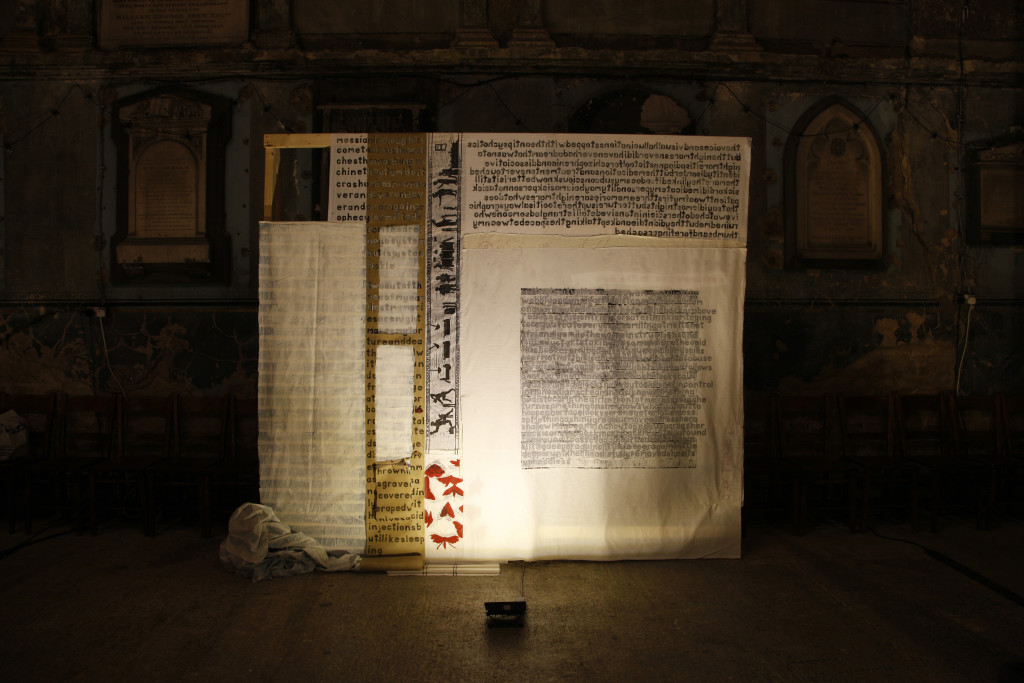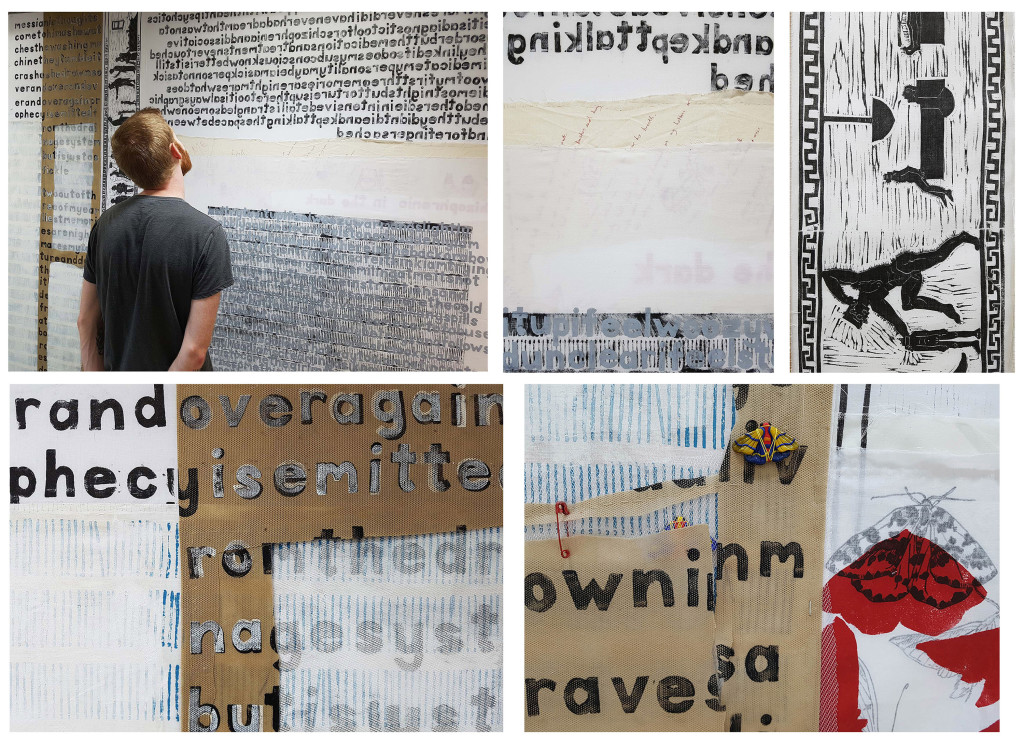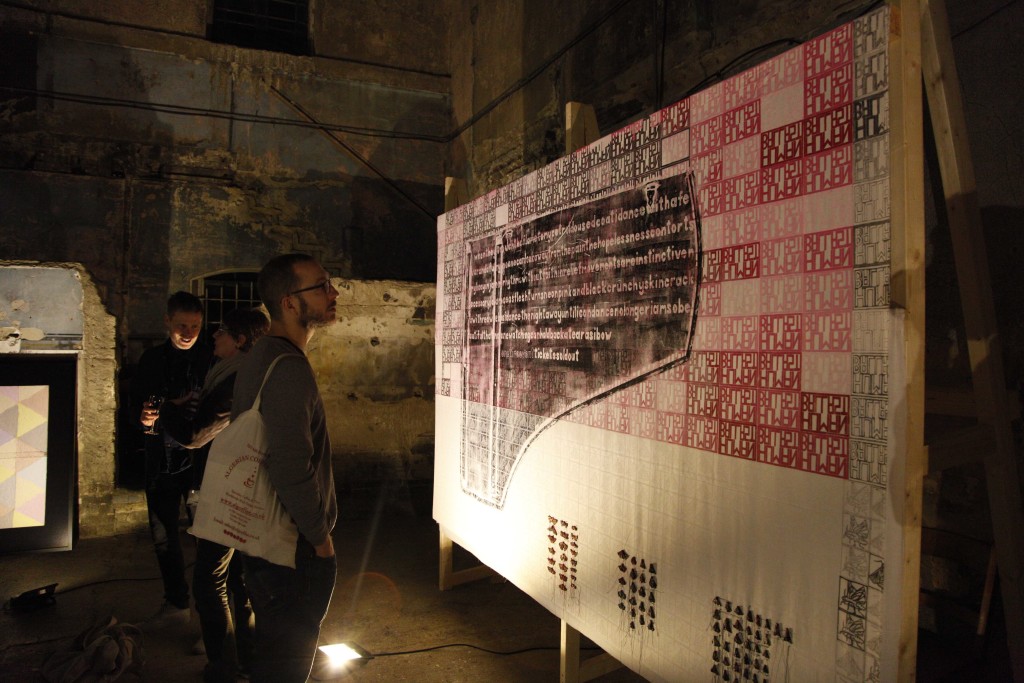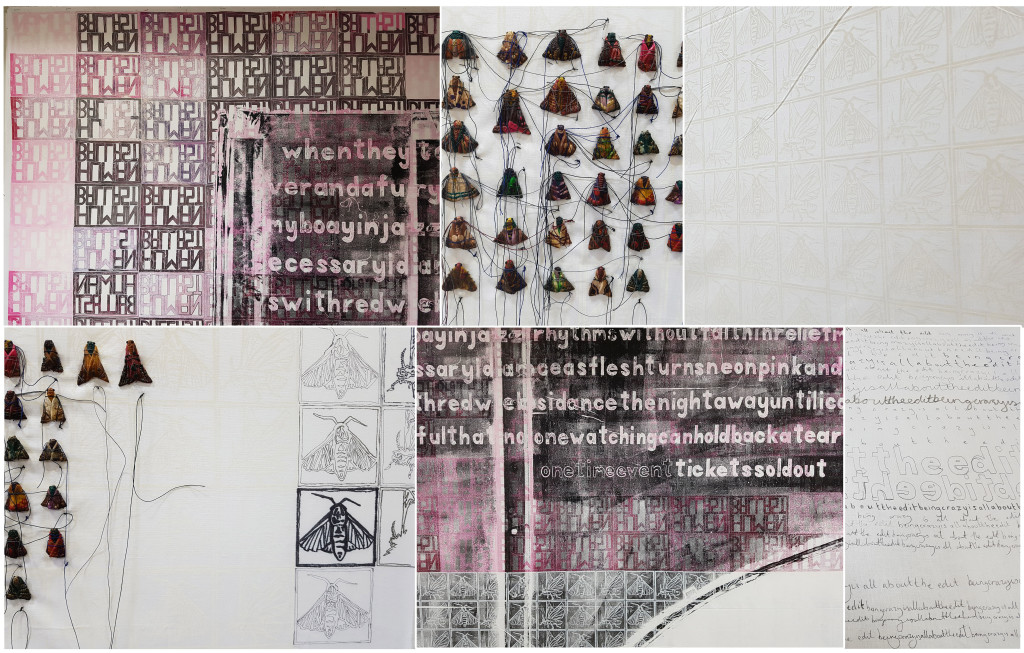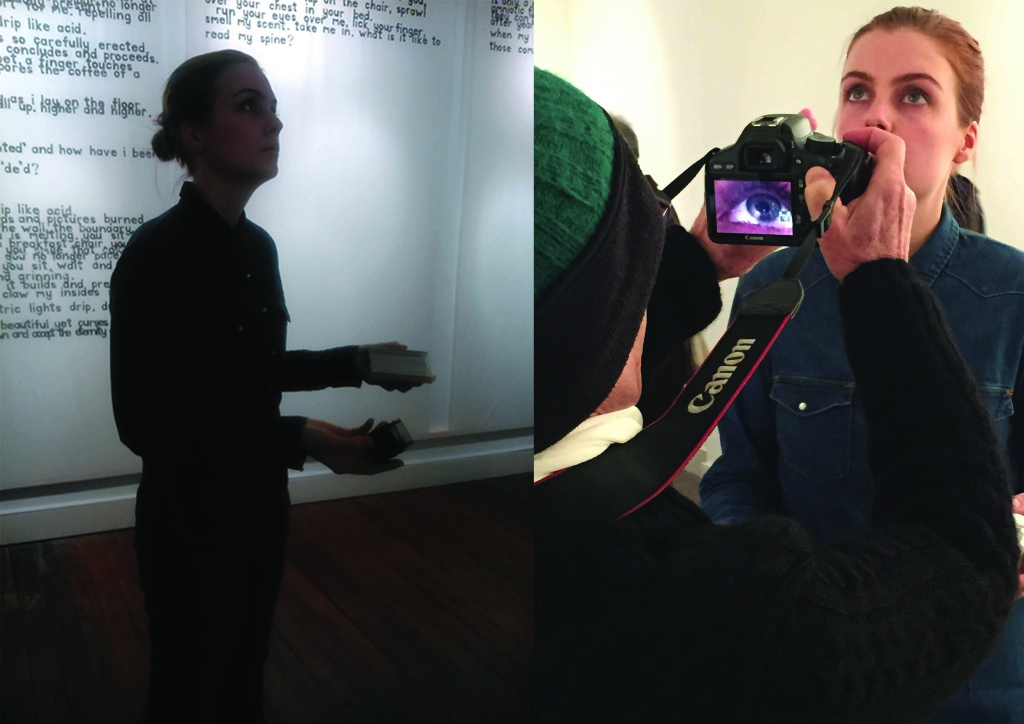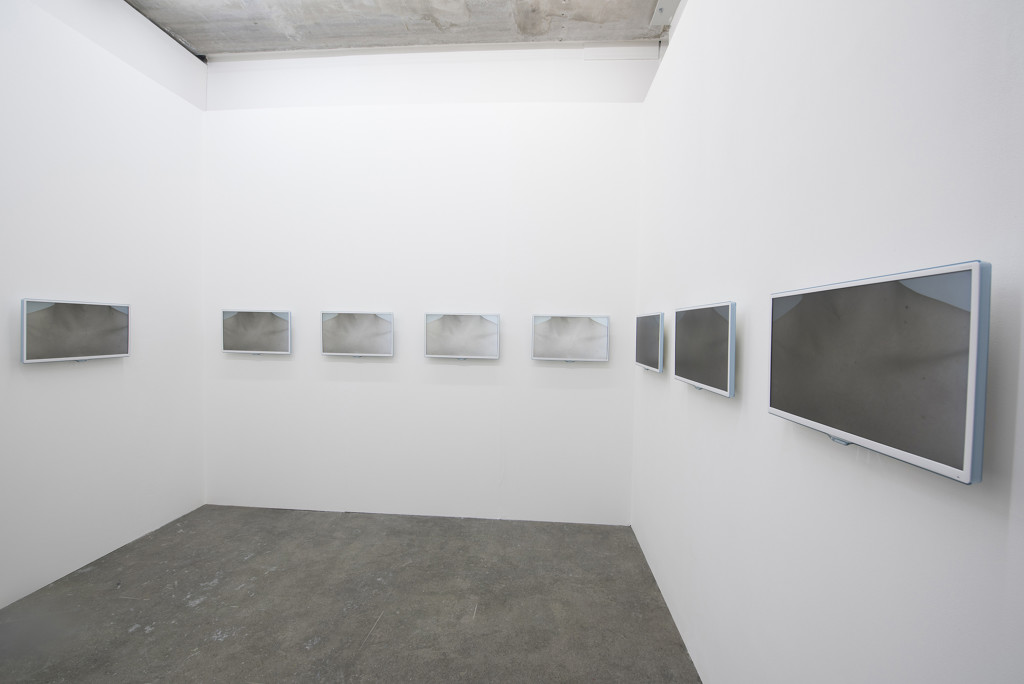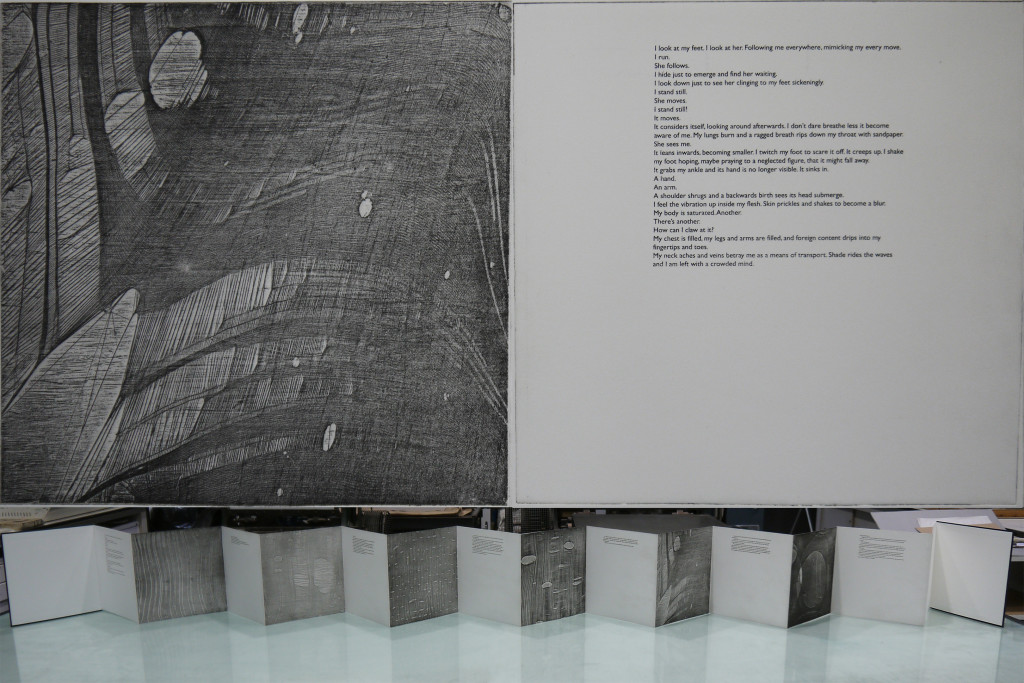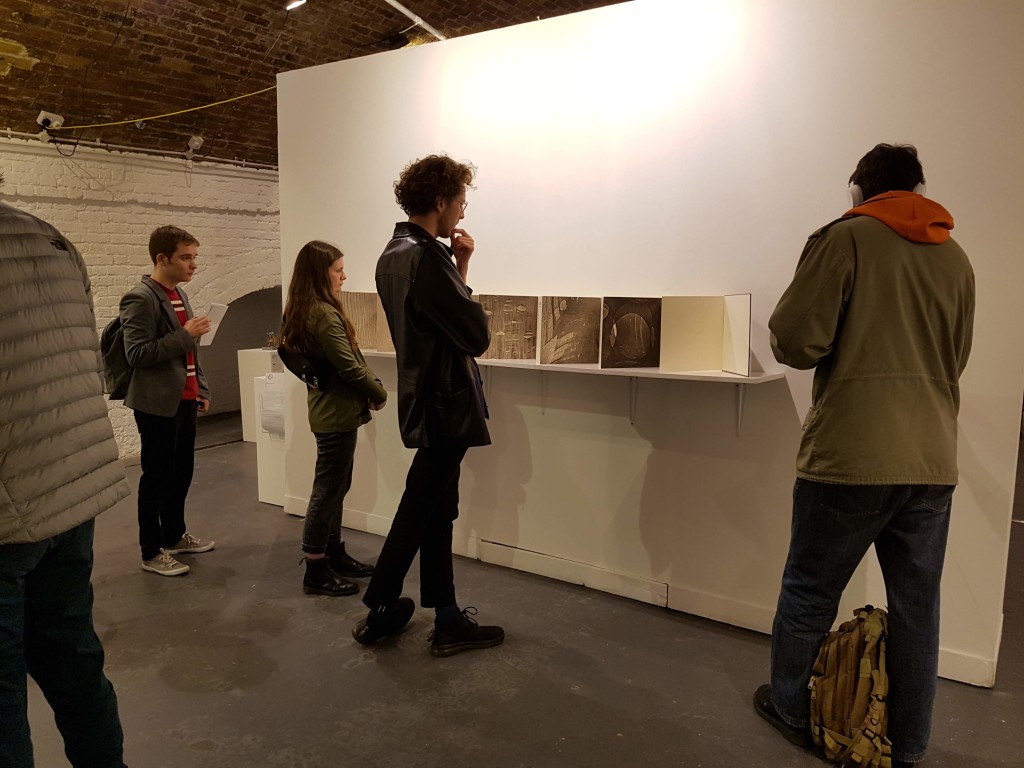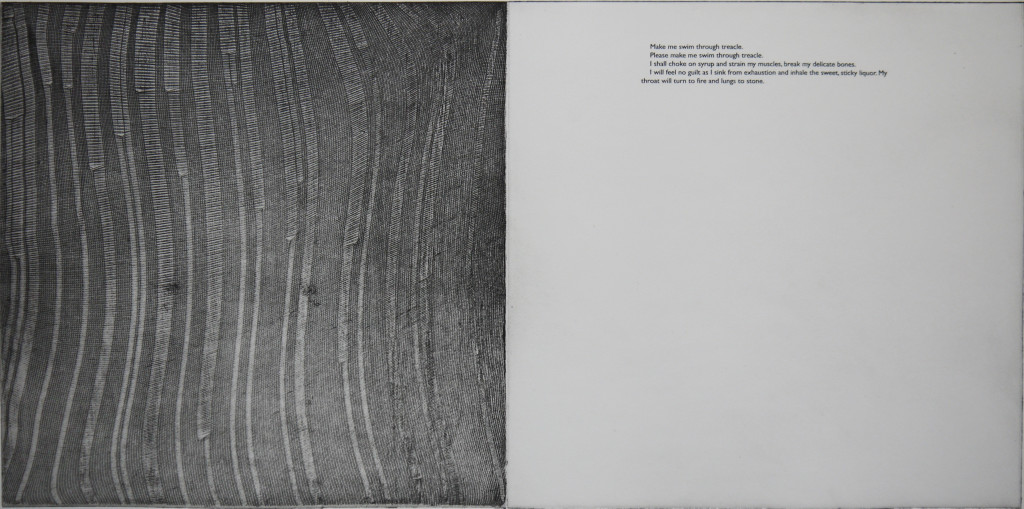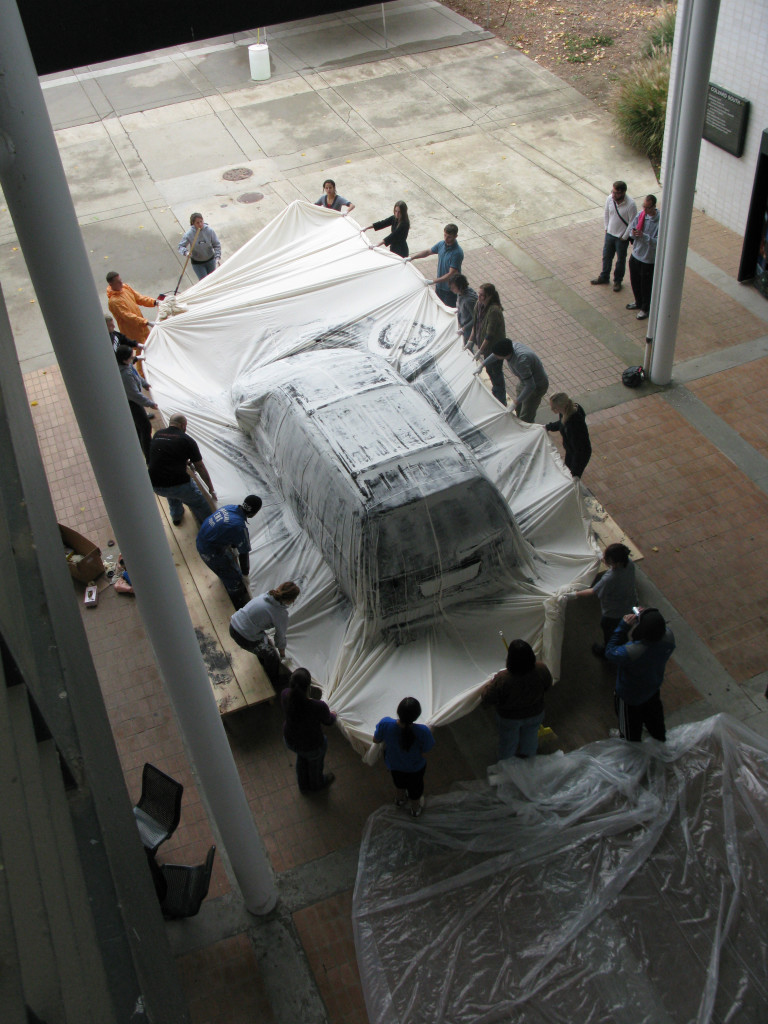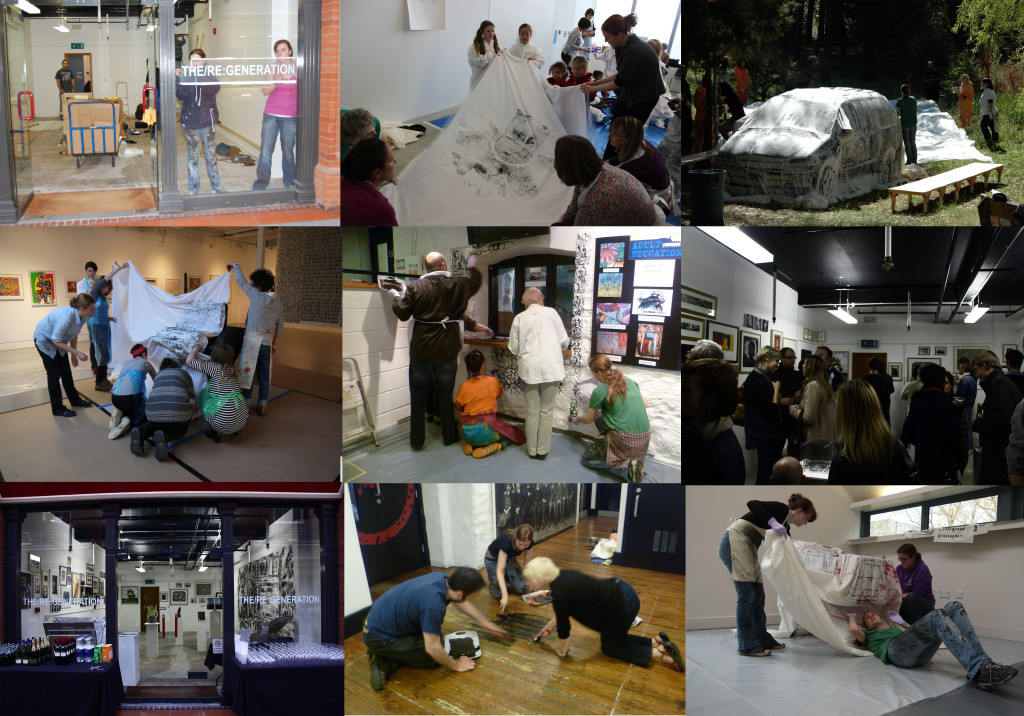JAY PRICE : PORTFOLIO
12 artworks / 15 images
1/ Work in Progress _the problem with prophets:
Concept sketch.
A hell scene of figures drawn from ancient texts, classical art, war photography, and artist anatomy books, will be laser etched into a sheet of clear acrylic. Behind the acrylic will be fabric that’s printed with flowers using potatoes. On top, text will be printed, the words taken from psychotic or manic documents the artist kept during periods of paranoia critiquing those in power, or during delusions of grandeur.
A stack of black paper and gold/bronze wax sticks (like those found in churches and later museums) will be placed on the floor beside the mounted plaque. The scene of the tormented people will not be visible until the viewer takes a rubbing of the work. The damned will be duplicated over and over.
The plaque itself will likely not be for sale (in contrast to the text on the image): so that no one can ever fully own the whole piece [decision is fluctuating]. Just take the warning and value and interpret it how they will.
Beware charismatic people seeking power.
–
2/ bronze rubbing plaques:
Handmade in the lost wax method and cast in bronze.
This artwork was a reaction to a summer of art fairs and made as a prototype for creating bronze rubbing plaques where the audience can take a direct rubbing of the piece to take away with them for free.
The work references rubbing plaques found on religious pilgrimages, comparing wealthy summer treks around worldwide art fairs to such a crusade. The piece explored creating accessible art for those who can’t afford the expensive entry price into the fairs, let alone the price of the artwork. It plays on the idea of expensive mediums and perceptions of value.
The text was an ejaculation of personal frustration to the work in these shows following established (safe) trends, and being a repetitive display of a few select artists.
This work ruminates on the question “can you make free artwork that the artist can still sell?”
–
3/ Grand piano lid carved rubbing:
A grand piano was covered with thick printmaking ink, wrapped in fabric, and a direct transfer removed. This half of the installation referenced the early work of the artist that had met with commercial success. The lid of the piano was removed and hand carved with text taken from documents the artist kept during a decade of psychotic episodes. The text was about burning alive on Maidstone high street and was selected due to its poetic, melodic nature, and as the physical experience had mimicked a dark dance where the body was contorted in jazz rhythms. The carved lid was left opposite the larger print with a roller, ink and stack of folded pieces of fabric cut to size. If they chose, the viewer could ink and take a print of the lid to take away for free.
The free element [lid] involved skilled crafts and time taken to create it. It was overlooked by the part of it on sale that took a fraction of the time to make. It was not mocking its viewer. It was questioning itself.
–
4/ No market value_2019_viewers cutting up large car print_interactive performance
Formerly a print of a Dodge Minivan (the most expensive work Price had made to date). The artwork was installed outside Unit1 Gallery London for the duration of a group show called “Auto Destruct”. Every day as the artwork deteriorated the artist would react to the overnight destruction. One night it was blown down but strong gales. It was reattached to the wall and mended, and the words “act of god” were printed onto the fabric. Dog footprints and bird faeces marked the print so they were highlighted with red ink and text was added with the value drop for “surface damage”. Every day the damage was marked and price drop recorded onto the work itself. On the final day the words “no market value” were printed across the work and members of the public were invited to a closing event where they could cut away any section they would like to take home. The work was framed, binned, even added into other artists’ artworks. Each individual participant decided the value of the piece.
–
5/ TAKE with a perforated edge_2016, lithography, alunminum, steel, interactive, aprox 96cm x 68cm x 100cm
A stack of lithographs that had 25 sections on each page that had been scored and perforated so that a segment could be torn out. On these sheets three different designs were available. Two had short text extracts taken from documents kept during psychotic episodes but with their context completely removed. One had images of empty frames (made from direct prints the artist had taken of frames from around their family homes, including those of recently deceased members).
For pondering the idea of free art the artist had been called arrogant by a now Turner Prize winning artist, who said no one would want a work by someone who was not famous. This was a fascinating opinion.
The artist wanted to know if people would engage with an artwork by an unknown artist. Also, what would they choose to take away: which types of text would they relate to, or would they pick classic imagery over challenging content? Did the setting influence these results?
–
6/ schizophrenicinthedark_SITD_2017, hand carved letters printed one at a time, relief carving, clay, textiles, pen, matches, ink, stitch, 273cm x 239cm
The works foundation was exploring the link between the sane and psychotic through the unconscious; specifically nightmares and recurring dreams. A very old diagnostic tool for schizophrenics was an individual history of nightmares and night terrors.
Every detail and connecting thread within the piece feeds from and into a specific moment/[false?] memory (?)/hallucination. It is within hand stitched codes, arduous process, materials, imagery, words, hidden elements, composition, insects… every element is there for a specific reason. If all are put together it is there to be deciphered, but whether that’s possible for the viewer is uncertain. It is not possible to verbalise or articulate it nor to corroborate or authenticate it.
The work includes thousands of printed matches, hand carved letters printed one at a time, hand made clay moths set on fire, stiches made with handmade needles based on old surgical sutures.
–
7/ SITD details :
Details of ‘schizophrenic in the dark’.
–
8/ redwebsandjazzrhythms, 2018, hand carved grand piano lid printed as a direct transfer, 610 relief prints, pen and text, stitch, textiles, 78 unique hand crafted clay moths, 320cm x 195cm
A large scale print made up of 610 relief prints, 75 clay moths that had been set on fire, biro pen drawing, a hand-carved and printed grand piano lid (with text taken from a document written after a psychotic hallucination of burning alive).
From a very young age I dreamed of burning. Whether it was being boiled in oil by magicians in nursery, or in my teenage years running from fires begging to be shot instead by fascists, or later during conscious hours burning alive in the street in early adulthood. It is one of my biggest fears and yet so beautiful every time it happens. Fascinating watching the skin crack exposing neon pink webs, watching skin float away and pop in boiling bubbles, or how the pain and heat contort my body in jazz rhythms. It’s haunting in every concept of the word.
–
9/ Details of redwebsandjazzrhythms
The background is made of the term “HUMAN BALLAST”. Before the holocaust the Nazi party used a term “BALLAST EXISTENZ” for propaganda campaigns for the forced sterilization, segregation & involuntary euthanasia of disabled & mentally ill people – “life unworthy of life”. This idea was taken from the UK & USA, where a number of notable political figures were pushing for ‘progressive evolution’. What’s fascinating was the term. Ballast is used to weigh down a ship; it in essence drags the vessel down – the metaphor to show ‘inferior’ people weighing down society & the economy. But ballast is essential to keep a ship afloat. Without it the ship would bob on the water & capsize – sinking the entire crew. Everyone is essential in society, different types of people and life offer new perspectives, experiences & allow us to empathize & be the best type of life we can be – if we’re all the same then any deviance from the norm would be an outcast & we would never evolve as species.
–
10/ Denim_2016_interactive endurance performance
Photographs taken by visitors and found on social media: The second in a series of endurances performances that the artist used to watch and evaluate the audience.
To evaluate how viewers relate to artwork Price monitored the audience by placing themselves within the gallery as art. There was always a small participatory element to the performance that the viewer would have to figure out (if they dared).
The artist quickly became “object” within the space and social regulations broke down between the viewer and themselves. The artist was touched, moved, threatened with violence, ignored, spat on, confessed to, became parts of intimate conversations people did not wish to be overheard, another artist even claimed the performance to be their work to interested gallerists.
11/ LABELS, 2015, experiential installation (accompanied by an 80 hour endurance performance), 11 synced screens with sound and room build, 6 hour duration
Photograph: One of a series of immersive video installations where an alien experience was simulated for the viewer to enter.
11 synced screens played 11 videos of a single individual reading different extracts taken from documents the artist kept during psychotic episodes. The recording was of the reader’s throat. The voices would change from all male, to female spoken with intonation, to androgynous spoken in monotone. There were points where all screens were speaking, moments where only certain screens spoke, and times when all were simply breathing.
All screens speaking at once created an overwhelming space of noise. It would take the action of the viewer to step closer to each individual screen to hear the words clearly.
The artist replicated their experience of having 11 voices, and presented the tangible sensation for ‘outsiders’. Multiple and psychical, yet without source, and from a single place.
The groundwork to empathy is shared experience.
–
12/ Crowded Mind_2015, handboundbook with 7 text photoetchings and 6 softground etchings made from sculptures with tights 30cm x 30cm
The form of the book was intimate, personal. It’s medium reflected it’s contents and was considerate of the form of image to complement the text.
“Barriers laddered in my mind”. [Extract from text]
The artist felt a connection with the way the mind is separated between sanity and insanity by such a frail and pregnable barrier. Ladders in tights were an elegant representation of the disintegration into a different state of mind.
The images of ladders in stockings were made by stretching tights around painted boards. The ladders were made, pulled, and layered in different ways to reflect the text they were partnered with. A steel plate was covered in soft beeswax and the fabric boards laid carefully on top. Pressure was exerted directly down using a beavers press. The board was then carefully removed and everywhere the fabric touched the wax it had pulled it away leaving a faint imprint of the ladders. The metal plate was then placed in an acid bath to be turned into an etching.
–
13/ Crowded mind plus recording:
As the artist grew in confidence sharing these intimate peculiarities the book concertinaed outwards to envelop more than one reader at a time.
Accessibility became a consideration to the artist when working with other people with impairments on exhibitions. The work had a corresponding sound recording created using actors and the artist themselves in order to make the work accessible to the visually impaired. The parallel work explored inflection, monotone and perceptions of gendered voices to simulate a sensation that the images added to the text when viewing it: not making it less than the original piece but equal to it in its own right so that it was not a token gesture but a sincerely accessible reflection.
–
14/ Printing minivan: finale of recession impressions:
Photograph the creation of the artist’s largest work.
[North Carolina] Price created a series of public events exploring printmaking as the medium of the recession: “Recession Impressions.”
The artist invited external companies to join the festival.
Drive-by Press: had a printing press in the back of their truck and let members of the public pick from woodcuts, ink them, and print them onto t-shirts they could buy for $5. Price ran a woodcut workshop so people could print their own designs.
Combat Paper: the University Price was in residence at was a young veterans school. Combat paper created paper from old, unworn service uniforms. They had created a method of spraying paper mulch through loose-mesh screen-print screens so it embedded in the drying paper. The images were of the officers wearing their uniforms. Students were offered the chance to partake if they felt conformable.
The culmination of the events was with Price printing vehicles.
–
15/ Selected examples of projects the artist has organised:
A series of exhibitions in local shops left empty by the recession and the following austerity. In these projects Price worked with local councils and artists, creating a network of creative practitioners that could support each other during troubled times and encouraging a local interaction with fine art. No commission was taken to enable lower pricing and enable more people to collect works, and support artists with sales. Press coverage was extensive and included celebrity artists such as Vic Reeves. Owners were pleased that their properties were fixed up during the process to support them with renting and selling. Local companies sponsored different shows to support with certain running costs in exchange for promotion of their businesses.
Large-scale off-press printmaking: working with people with mental illness, elderly, students and groups of youngsters. Locations included empty breweries to the Turner Contemporary.


